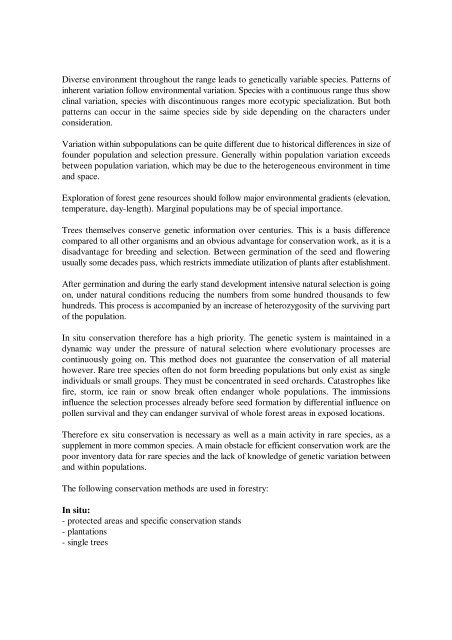Integration of Conservation Strategies of Plant Genetic ... - Genres
Integration of Conservation Strategies of Plant Genetic ... - Genres
Integration of Conservation Strategies of Plant Genetic ... - Genres
Create successful ePaper yourself
Turn your PDF publications into a flip-book with our unique Google optimized e-Paper software.
Diverse environment throughout the range leads to genetically variable species. Patterns <strong>of</strong><br />
inherent variation follow environmental variation. Species with a continuous range thus show<br />
clinal variation, species with discontinuous ranges more ecotypic specialization. But both<br />
patterns can occur in the saime species side by side depending on the characters under<br />
consideration.<br />
Variation within subpopulations can be quite different due to historical differences in size <strong>of</strong><br />
founder population and selection pressure. Generally within population variation exceeds<br />
between population variation, which may be due to the heterogeneous environment in time<br />
and space.<br />
Exploration <strong>of</strong> forest gene resources should follow major environmental gradients (elevation,<br />
temperature, day-length). Marginal populations may be <strong>of</strong> special importance.<br />
Trees themselves conserve genetic information over centuries. This is a basis difference<br />
compared to all other organisms and an obvious advantage for conservation work, as it is a<br />
disadvantage for breeding and selection. Between germination <strong>of</strong> the seed and flowering<br />
usually some decades pass, which restricts immediate utilization <strong>of</strong> plants after establishment.<br />
After germination and during the early stand development intensive natural selection is going<br />
on, under natural conditions reducing the numbers from some hundred thousands to few<br />
hundreds. This process is accompanied by an increase <strong>of</strong> heterozygosity <strong>of</strong> the surviving part<br />
<strong>of</strong> the population.<br />
In situ conservation therefore has a high priority. The genetic system is maintained in a<br />
dynamic way under the pressure <strong>of</strong> natural selection where evolutionary processes are<br />
continuously going on. This method does not guarantee the conservation <strong>of</strong> all material<br />
however. Rare tree species <strong>of</strong>ten do not form breeding populations but only exist as single<br />
individuals or small groups. They must be concentrated in seed orchards. Catastrophes like<br />
fire, storm, ice rain or snow break <strong>of</strong>ten endanger whole populations. The immissions<br />
influence the selection processes already before seed formation by differential influence on<br />
pollen survival and they can endanger survival <strong>of</strong> whole forest areas in exposed locations.<br />
Therefore ex situ conservation is necessary as well as a main activity in rare species, as a<br />
supplement in more common species. A main obstacle for efficient conservation work are the<br />
poor inventory data for rare species and the lack <strong>of</strong> knowledge <strong>of</strong> genetic variation between<br />
and within populations.<br />
The following conservation methods are used in forestry:<br />
In situ:<br />
- protected areas and specific conservation stands<br />
- plantations<br />
- single trees










